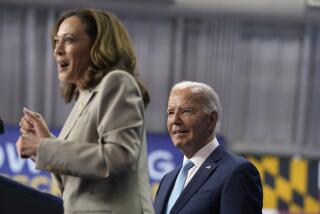The Mystery Behind Nagging Inflation
The price of oil, that inflationary terror of the 1970s, has declined for most of this decade and increases in food prices and wages in the 1980s have been relatively modest, if steady.
Yet inflation still casts a big and controversial shadow on the economy--and may ultimately be curbed only by a recession.
Nobody seems to know whatâs really happening. On Sunday, federal budget director Richard Darman criticized the Federal Reserve for keeping interest rates high in an attempt to check inflation. But on Tuesday President Bush pointed out, âYou also have to be concerned about inflation.â
What inflation? The trouble is no two experts agree on what is causing prices to rise--the consumer price index rose 5.3% in the 12 months to June 30--or what really can be done to curb them.
Their theories, however, point to a different economy than we used to know. Economist Donald Ratajczak, of Atlantaâs Georgia State University, says legal and insurance costs are causing inflation. âThe cost of making the products hasnât gone up that much,â says Ratajczak, âbut everything carries a legal and insurance fee, and we have stores every few blocks--so we can be protected and convenienced at the same time.
âWe pay for that,â says Ratajczak, who is trying to determine total legal costs in the U.S. economy--so far without success. âBut the number of lawyers is increasing at four times the general employment rate, so something is happening,â he says.
The Labor Departmentâs official figures cite rising college tuitions and medical costs as big contributors to the inflation rate. Others mention the cost of automobile insurance, which has been rising much faster than the price of cars.
One reason we have inflation, argues economist Murray Weidenbaum of Washington University, St. Louis, âis that all those are services, not goods, and not subject to foreign competition as manufacturing industry has been.â Economist James Galbraith of the University of Texas points out that without cheap imports in the 1980s, prices of manufactured goods would be up as well.
Whatâs the bottom line? That when there is so much confusion, something else may be going on that is beyond day-to-day calculations.
The truth is, we may still be going through one of the great ages of inflation, times in world history when prices rise dramatically but nobody can explain all the reasons why.
Over a decade ago, during the raging inflation of the 1970s, Forbes magazine published a highly original 1,000-year study of price rises based on the work of scholars at Englandâs Oxford University. They had found that inflation was not a routine occurrence but an epochal event; that in four great waves, coinciding with four periods of dramatic social change, inflation has taken off and lifted prices to new, permanently higher levels.
Decline of Feudalism
In between such periods, as between ice ages, things settle down and prices pulsate up and down.
Prices rose dramatically, for example, from about AD 1150 to 1275 as agriculture improved, people came into towns and started trading and lending money, and feudalism declined.
Inflation leaped again in the 1500s--as Europeans discovered gold and silver and new lands in the Americas, and plied new routes to Asia. But then inflation went dormant from 1600 to about 1750, when it took off again during the Industrial Revolution, creating a new surge of prices culminating just before 1900.
Then, for half of the 20th century, prices bounced up and down but began a long ascent after 1950 that continues to this day.
Rather than seeing inflation as only sinister, the study noted that all previous price rise periods coincided with an expansion of human knowledge. And our own day is certainly no exception to that. There is more demand for college, so the price of college goes up; medical advances beget demands for medical care, as human beings live longer than in former ages.
We learn more about the environment, and so demand clean air and water. But our economic systems lag our knowledge so the costs of cleanup, social investments though they are, also give prices an inflationary lift.
Fascinating, of course, but what can or should be done about rising prices? Thatâs a problem because services are less affected by interest rates than by incomes. That is, higher interest rates donât curb lawsuits, but if people lose their paychecks they might put off going to the doctor, or to college.
Thatâs why âit was high unemployment that kept inflation down most of this decade,â says economist David Levine of the Sanford C. Bernstein research firm, and why âif you want to reverse inflation now, you must raise unemployment.â
An unhappy choice, but at least a clear one. If we donât wish unemployment, we can either tolerate inflation, or redouble our efforts to control rising costs in medicine, education, liability insurance and the law. Or we could avoid the issue altogether as Washington is doing and simply argue about the Federal Reserve.
More to Read
Get the L.A. Times Politics newsletter
Deeply reported insights into legislation, politics and policy from Sacramento, Washington and beyond. In your inbox three times per week.
You may occasionally receive promotional content from the Los Angeles Times.










